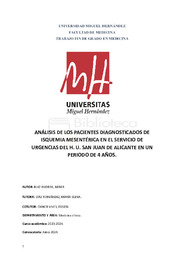Please use this identifier to cite or link to this item:
https://hdl.handle.net/11000/35574Análisis de los pacientes diagnosticados de isquemia mesentérica en el servicio de urgencias del H. U. san Juan de Alicante en un periodo de 4 años
| Title: Análisis de los pacientes diagnosticados de isquemia mesentérica en el servicio de urgencias del H. U. san Juan de Alicante en un periodo de 4 años |
| Authors: Ruiz Andreu, Nerea |
| Tutor: Díaz Fernández, María Elena Chiner Vives, Eusebi |
| Editor: Universidad Miguel Hernández |
| Department: Departamentos de la UMH::Medicina Clínica |
| Issue Date: 2024-05-12 |
| URI: https://hdl.handle.net/11000/35574 |
| Abstract: Introducción: La Isquemia mesentérica (IM) consiste en una reducción del flujo sanguíneo a nivel intestinal que ocasiona una elevada morbimortalidad. Método: Se realizó un estudio retrospectivo de 4 años analizando el comportamiento de la IM en el servicio de urgencias del HUSJ evaluando las características clínicas, epidemiológicas y factores de riesgo, además de correlacionar el triaje Manchester con la mortalidad, así como el tiempo transcurrido hasta la intervención, los factores de riesgo y comorbilidades con la mortalidad. Para el estudio estadístico se empleó la t student o el test de Wilconxon y el test de Chi cuadrado para las variables cualitativas. Resultados: Se estudiaron 40 pacientes, 60 % mujeres y 40% hombres, de 78 ± 14 años. La incidencia fue de 4/100000/año. Presentaron dolor abdominal 72.4%, 12.5%, hemorragia digestiva 10% y diarrea 5%, con un tiempo medio de evolución de los síntomas de 21 ± 22 horas. Se realizó TAC con contraste en 67.5%, angio TAC en 25% y sin contraste en 7.5%, objetivándose neumatosis intestinal en el 39%. Se apreció elevación del dímero D y acidosis por aumento del lactato en 40%. Los principales factores de riesgo fueron arritmias y enfermedad vascular periférica (EVP). Fueron intervenidos mediante laparotomía 42.5%, trombectomía 5% y el resto fue conservador. El tiempo medio hasta la cirugía fue de 8 ± 2 y el farmacológico 4 ± 1 hora. La mortalidad fue de 27.5%. Existió relación significativa entre triaje y Mortalidad, correspondiendo a los grados más graves (p=0.05). Los pacientes varones presentaron mayor ingreso en UCI (p=0,046) y EVP (p= 0,032). La mortalidad se relacionó con arritmias (p=0.019), complicaciones (p=0,041), intervención en UCI (0,005) y leucocitosis (p=0,02). Con tendencia en caso de isquemia oclusiva, enfermedad vascular periférica, Dislipemia, DM y neumatosis intestinal (p=0.06). Conclusiones: El triaje de los pacientes fue adecuado en nivel de gravedad y mortalidad. El dímero D y la leucocitosis fueron útiles en la sospecha clínica y en el pronóstico. Los principales factores de riesgo fueron las arritmias, EVP, isquemia obstructiva. La TAC fue básica para el diagnóstico siendo la neumatosis el hallazgo más específico y con peor pronóstico. La mortalidad en general fue baja probablemente por mayor conocimiento, diagnóstico y tratamiento temprano. Introduction: Mesenteric ischaemia (MI) consists of reduced blood flow at the intestinal level causing high morbidity and mortality. Method: A 4-year retrospective study was conducted analysing the behaviour of MI in the emergency department of the HUSJ evaluating clinical, epidemiological characteristics and risk factors, in addition to correlating Manchester triage with mortality, as well as time to intervention, risk factors and comorbidities with mortality. Student's t-test or Wilconxon's test and Chi-square test for qualitative variables were used for statistical study. Results: Forty patients, 60 % female and 40 % male, aged 78 ± 14 years, were studied. The incidence was 4/100000/year. Abdominal pain 72.4%, 12.5%, gastrointestinal bleeding 10% and diarrhoea 5%, with a mean symptom evolution time of 21 ± 22 hours. Contrast-enhanced CT was performed in 67.5%, angio CT in 25% and non-contrast in 7.5%, with intestinal pneumatosis in 39%. Elevated D-dimer and acidosis due to increased lactate were observed in 40%. The main risk factors were arrhythmias and peripheral vascular disease (PVD). Surgery was performed by laparotomy 42.5%, thrombectomy 5% and the rest was conservative. Mean time to surgery was 8 ± 2h and pharmacological time 4 ± 1 hour. Mortality was 27.5%. There was a significant relationship between triage and mortality, corresponding to the most severe degrees (p=0.05). Male patients had higher ICU admission (p=0.046) and evp (p=0.032). Mortality was related to arrhythmias (p=0.019), complications (p=0.041), ICU intervention (0.005) and leukocytosis (p=0.02). With tendency in case of occlusive ischaemia, peripheral vascular disease, Dyslipemia, DM and intestinal pneumatosis (p=0.06). Conclusions: Triage of patients was adequate in severity level and mortality. D-dimer and leukocytosis were useful in clinical suspicion and prognosis. The main risk factors were more arrhythmias, PVE, obstructive ischaemia. CT was basic for diagnosis with pneumatosis being the most specific finding and with the worst prognosis. Overall mortality was low, probably due to increased awareness, diagnosis and early treatment. |
| Keywords/Subjects: Isquemia mesentérica mortalidad triaje factores de riesgo |
| Knowledge area: CDU: Ciencias aplicadas: Medicina |
| Type of document: info:eu-repo/semantics/bachelorThesis |
| Access rights: info:eu-repo/semantics/openAccess |
| Appears in Collections: TFG- Medicina |
.png)

